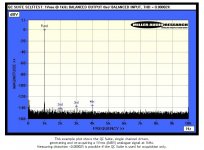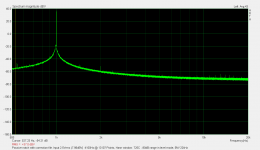Oh. I thought you meant 3rd world food. I really mean third world. Jungle food. Caught and prepped as is done with minimum fan fare. You know, the ones who never used a spoon or fork? never seen a stove?
-RM
Real back country.
Oh. I thought you meant 3rd world food. I really mean third world. Jungle food. Caught and prepped as is done with minimum fan fare. You know, the ones who never used a spoon or fork? never seen a stove?
I await your report.
Iquitos, Peru, in the heart of the Amazon. He wrestles giant paiche fish, hits local markets for grilled coconut grubs and smoked jungle rodents, and forages for giant biting ants with a tribal shaman.
Back OT, found this from Peter Miller's Miller Audio Research. Pretty good loopback performance for (I assume) commercial DAC's and A/D's. THD about -135dB mostly only the 4th. Claims the A/D alone is a little better. How does he verify? I suspect this box is not cheap.
Attachments
Back OT, found this from Peter Miller's Miller Audio Research. Pretty good loopback performance for (I assume) commercial DAC's and A/D's. THD about -135dB mostly only the 4th. Claims the A/D alone is a little better. How does he verify? I suspect this box is not cheap.
A/D performance is mostly the ADC chip performance. And if the ADC shows very good performance with the one specific input signal level, then it does not mean that this ADC can show every signal (in working range) also with a good performance. Artifacts are usually seemed, and every ADC must be investigated within all input signal range. Would be interesting, if we shall see ADC performance with at least 5dB input level steps down to app. -50dB range.
Victor.
I await your report.
Iquitos... yes, the airplane lands there and then go out from there by rented river boat.
-RM
Last edited:
How does he verify? I suspect this box is not cheap.
Yes, verify. Otherwise, no cigar. With test equipment some corrections can be applied to improve linearity at low levels. But measuring it accurately to get those corrections would be a challenge.
The rising harmonic is strange.... like some suppression of harmonics is already occurring for the 2-3H ones. ??
perhaps this concept could be adapted to extend measurments.
https://www.researchgate.net/public...nsitive_method_for_voltage_noise_measurements
THx-RNMarsh
Last edited:
Now you need to truly experience the culture by doing the funky food. Stinking tofu, snake wine, chicken uterus, sea "cucumber", the fat behind the fish eye is the special treat.
and don't forget tarantula legs.
and don't forget tarantula legs.
I might actually try what I saw which was totally fried crispy. I've had fried bugs but totally crisp they are not very challenging in fact only in imagination.
The rising harmonic is strange.... like some suppression of harmonics is already occurring for the 2-3H ones. ??
perhaps this concept could be adapted to extend measurments.
https://www.researchgate.net/public...nsitive_method_for_voltage_noise_measurements
THx-RNMarsh
A/D harmonics don't necessarily fall monotonically with frequency.
The essence of that paper is still the cross-correlating concept. AD743's again, that's why they call me mrnoiz.
A/D performance is mostly the ADC chip performance. And if the ADC shows very good performance with the one specific input signal level, then it does not mean that this ADC can show every signal (in working range) also with a good performance. Artifacts are usually seemed, and every ADC must be investigated within all input signal range. Would be interesting, if we shall see ADC performance with at least 5dB input level steps down to app. -50dB range.
Victor.
True but in most serious power amp tests you are passively attenuating down to the 1V rms level and most line/preamp tests would be at around this level with the input being passively attenuated, both of which can be done at very low THD levels.
A/D harmonics don't necessarily fall monotonically with frequency.
The essence of that paper is still the cross-correlating concept. AD743's again, that's why they call me mrnoiz.
Don't need perfection... if we can also get -30db reduction, that would help us lower the thd threshold of detection/measure.
what would be needed to try this on something we might have laying around?
TH-RNMarsh
Mike
@ Mike/fredbloggstwo -
Here is a link to my HP 339A blog, on DIY, where I summarized and linked to a couple of different threads/discussions from all the good folks here.
Be warned - It's ugly but it works. It will help anyone who has an
interest in the HP339A.
@ David, Thanks. Nuts, no sound card here, other than the built in.
@ Demian, The culprit who turned us all on to the Shibasoku 725s.
Anyone know if you can import data through a serial or parallel port?
Or I'm wondering about Shibasoku
BNC Analysis Output to:
DELL Laptop w/
Network Interface - receptacle
3 USB ports
1 HDMI ports
Anyone tried "Porting" the Analysis data from the 725D to
GBIP or the "Port" Port? In the mean time I can't recall if
we can port the analysis data or it's only available through
the analysis port.
Cheers,
Shibasoku 725D Manual, Schematic, Calibration Proceedure
If anybody out there has a
Shibasiku 725D Owners Manual, Service Manual
Calibration Manual, Schematics, etc...
please PM me for email address to send me the information.
I promise not to publish any information given to me.
The information isn't readily available and is needed.
For the right stuff there may even be a cache reward.
Cheers,
If anybody out there has a
Shibasiku 725D Owners Manual, Service Manual
Calibration Manual, Schematics, etc...
please PM me for email address to send me the information.
I promise not to publish any information given to me.
The information isn't readily available and is needed.
For the right stuff there may even be a cache reward.
Cheers,
@ Mike/fredbloggstwo -
Here is a link to my HP 339A blog, on DIY, where I summarized and linked to a couple of different threads/discussions from all the good folks here.
Be warned - It's ugly but it works. It will help anyone who has an
interest in the HP339A.
,
Thanks for the reply - can't see any link though.
Mike
The data you can get from the 725 is all in the GPIB command set. Its not anything like the FFT plots we are sharing.
You need a decent sound card to capture the data. At a minimum an EMU Tracker Pre (the current USB device from them). I recently discovered that the Asus Xonar DX has a pretty decent ADC and DAC for this stuff. It can be had for as little at $60 on eBay. The harmonics in a loopback at the ideal levels (about -15 dBFS) are in the -125 dB range.
You also need software. Davida uses Arta. Jens uses Virtins. Victor uses something else. I use praxis, Arta and the Wavetek FFT depending. They give similar results under similar conditions.
You need a decent sound card to capture the data. At a minimum an EMU Tracker Pre (the current USB device from them). I recently discovered that the Asus Xonar DX has a pretty decent ADC and DAC for this stuff. It can be had for as little at $60 on eBay. The harmonics in a loopback at the ideal levels (about -15 dBFS) are in the -125 dB range.
You also need software. Davida uses Arta. Jens uses Virtins. Victor uses something else. I use praxis, Arta and the Wavetek FFT depending. They give similar results under similar conditions.
I repeated the passive notch measurment of my SVo on the Shibasoku 725C.
The 725C doesn't have the range of the 725D. 0dBV is - 90dBV in the following pic.
I made up a notch filter correction file using the built in FR (Frequency Response) software in ARTA. The file loads as a mic compensation file.
I've included the correction file for inspection.
The 2nd harmonic measure -51.62dBV - 90dBV = -141.62dBV
The input is 1kHz @ 7.96dBV.
Therefore -141.62dBV -7.96dBV = -149.58dBV 2nd Harmonic.
We are down from -90dBV at 0dB. Remember to add 10dB to the noise for a correct noise floor.
The 725C doesn't have the range of the 725D. 0dBV is - 90dBV in the following pic.
I made up a notch filter correction file using the built in FR (Frequency Response) software in ARTA. The file loads as a mic compensation file.
I've included the correction file for inspection.
The 2nd harmonic measure -51.62dBV - 90dBV = -141.62dBV
The input is 1kHz @ 7.96dBV.
Therefore -141.62dBV -7.96dBV = -149.58dBV 2nd Harmonic.
We are down from -90dBV at 0dB. Remember to add 10dB to the noise for a correct noise floor.
Attachments
Last edited:
I recently discovered that the Asus Xonar DX has a pretty decent ADC and DAC for this stuff. It can be had for as little at $60 on eBay.
The cheap Asus stuff shocked the heck out of me, the ASIO drivers worked out of the box with ARTA.
I wish the windows connections of the Asus drivers worked OK. I can't get them to work reliably above 48 KHz. Sometimes the ADC seems to but not the DAC on either Win 10 or XP. The ASIO side works perfectly. The driver is from CMedia who usually have this together. I'll try the CMedia version this weekend and see if the WMA side behaves correctly. Its certainly the best performance of an ADC under $$$ I have seen so far. I don't know anything about the other Asus cards, just the DX.
- Home
- Design & Build
- Equipment & Tools
- Low-distortion Audio-range Oscillator

